Entry Database : PDB / ID : 2a0qTitle Structure of thrombin in 400 mM potassium chloride Thrombin, heavy chain Thrombin, light chain Keywords / Function / homology Function Domain/homology Component
/ / / / / / / / / / / / / / / / / / / / / / / / / / / / / / / / / / / / / / / / / / / / / / / / / / / / / / / / / / / / / / / / / / / / / / / / / / / / / / / / / / / / / / / / / / / / / / / / / / / / / / / / / / / / / / / / / Biological species Homo sapiens (human)Method / / / Resolution : 1.9 Å Authors Papaconstantinou, M. / Carrell, C.J. / Pineda, A.O. / Bobofchak, K.M. / Mathews, F.S. / Flordellis, C.S. / Maragoudakis, M.E. / Tsopanoglou, N.E. / di Cera, E. Journal : J.Biol.Chem. / Year : 2005Title : Thrombin Functions through Its RGD Sequence in a Non-canonical Conformation.Authors : Papaconstantinou, M.E. / Carrell, C.J. / Pineda, A.O. / Bobofchak, K.M. / Mathews, F.S. / Flordellis, C.S. / Maragoudakis, M.E. / Tsopanoglou, N.E. / Di Cera, E. History Deposition Jun 16, 2005 Deposition site / Processing site Revision 1.0 Jul 12, 2005 Provider / Type Revision 1.1 Apr 30, 2008 Group Revision 1.2 Jul 13, 2011 Group Revision 1.3 Oct 11, 2017 Group / Category Item _software.classification / _software.contact_author ... _software.classification / _software.contact_author / _software.contact_author_email / _software.date / _software.language / _software.location / _software.name / _software.type / _software.version Revision 2.0 Jul 29, 2020 Group Atomic model / Data collection ... Atomic model / Data collection / Derived calculations / Structure summary Category atom_site / chem_comp ... atom_site / chem_comp / entity / pdbx_chem_comp_identifier / pdbx_entity_nonpoly / pdbx_struct_conn_angle / struct_conn / struct_site / struct_site_gen Item _atom_site.auth_atom_id / _atom_site.label_atom_id ... _atom_site.auth_atom_id / _atom_site.label_atom_id / _chem_comp.name / _chem_comp.type / _entity.pdbx_description / _pdbx_entity_nonpoly.name / _pdbx_struct_conn_angle.ptnr1_PDB_ins_code / _pdbx_struct_conn_angle.ptnr1_auth_asym_id / _pdbx_struct_conn_angle.ptnr1_auth_comp_id / _pdbx_struct_conn_angle.ptnr1_auth_seq_id / _pdbx_struct_conn_angle.ptnr1_label_asym_id / _pdbx_struct_conn_angle.ptnr1_label_comp_id / _pdbx_struct_conn_angle.ptnr1_label_seq_id / _pdbx_struct_conn_angle.ptnr3_PDB_ins_code / _pdbx_struct_conn_angle.ptnr3_auth_asym_id / _pdbx_struct_conn_angle.ptnr3_auth_comp_id / _pdbx_struct_conn_angle.ptnr3_auth_seq_id / _pdbx_struct_conn_angle.ptnr3_label_asym_id / _pdbx_struct_conn_angle.ptnr3_label_comp_id / _pdbx_struct_conn_angle.ptnr3_label_seq_id / _pdbx_struct_conn_angle.value / _struct_conn.pdbx_dist_value / _struct_conn.pdbx_ptnr1_PDB_ins_code / _struct_conn.pdbx_ptnr2_PDB_ins_code / _struct_conn.ptnr1_auth_asym_id / _struct_conn.ptnr1_auth_comp_id / _struct_conn.ptnr1_auth_seq_id / _struct_conn.ptnr1_label_asym_id / _struct_conn.ptnr1_label_atom_id / _struct_conn.ptnr1_label_comp_id / _struct_conn.ptnr1_label_seq_id / _struct_conn.ptnr2_auth_asym_id / _struct_conn.ptnr2_auth_comp_id / _struct_conn.ptnr2_auth_seq_id / _struct_conn.ptnr2_label_asym_id / _struct_conn.ptnr2_label_atom_id / _struct_conn.ptnr2_label_comp_id / _struct_conn.ptnr2_label_seq_id Description / Provider / Type Revision 2.1 Oct 20, 2021 Group / Structure summary / Category / database_2 / struct_ref_seq_difItem _chem_comp.pdbx_synonyms / _database_2.pdbx_DOI ... _chem_comp.pdbx_synonyms / _database_2.pdbx_DOI / _database_2.pdbx_database_accession / _struct_ref_seq_dif.details Revision 2.2 Oct 30, 2024 Group / Structure summaryCategory chem_comp_atom / chem_comp_bond ... chem_comp_atom / chem_comp_bond / pdbx_entry_details / pdbx_modification_feature
Show all Show less
 Open data
Open data Basic information
Basic information Components
Components Keywords
Keywords Function and homology information
Function and homology information Homo sapiens (human)
Homo sapiens (human) X-RAY DIFFRACTION /
X-RAY DIFFRACTION /  SYNCHROTRON /
SYNCHROTRON /  MOLECULAR REPLACEMENT / Resolution: 1.9 Å
MOLECULAR REPLACEMENT / Resolution: 1.9 Å  Authors
Authors Citation
Citation Journal: J.Biol.Chem. / Year: 2005
Journal: J.Biol.Chem. / Year: 2005 Structure visualization
Structure visualization Molmil
Molmil Jmol/JSmol
Jmol/JSmol Downloads & links
Downloads & links Download
Download 2a0q.cif.gz
2a0q.cif.gz PDBx/mmCIF format
PDBx/mmCIF format pdb2a0q.ent.gz
pdb2a0q.ent.gz PDB format
PDB format 2a0q.json.gz
2a0q.json.gz PDBx/mmJSON format
PDBx/mmJSON format Other downloads
Other downloads 2a0q_validation.pdf.gz
2a0q_validation.pdf.gz wwPDB validaton report
wwPDB validaton report 2a0q_full_validation.pdf.gz
2a0q_full_validation.pdf.gz 2a0q_validation.xml.gz
2a0q_validation.xml.gz 2a0q_validation.cif.gz
2a0q_validation.cif.gz https://data.pdbj.org/pub/pdb/validation_reports/a0/2a0q
https://data.pdbj.org/pub/pdb/validation_reports/a0/2a0q ftp://data.pdbj.org/pub/pdb/validation_reports/a0/2a0q
ftp://data.pdbj.org/pub/pdb/validation_reports/a0/2a0q Links
Links Assembly
Assembly
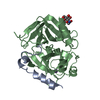

 Components
Components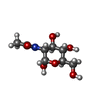

 Homo sapiens (human) / Gene: F2 / Cell (production host): kidney cells / Production host:
Homo sapiens (human) / Gene: F2 / Cell (production host): kidney cells / Production host: 
 Homo sapiens (human) / Gene: F2 / Cell (production host): kidney cells / Production host:
Homo sapiens (human) / Gene: F2 / Cell (production host): kidney cells / Production host: 





 X-RAY DIFFRACTION / Number of used crystals: 1
X-RAY DIFFRACTION / Number of used crystals: 1  Sample preparation
Sample preparation SYNCHROTRON / Site:
SYNCHROTRON / Site:  APS
APS  / Beamline: 14-BM-C / Wavelength: 0.9 Å
/ Beamline: 14-BM-C / Wavelength: 0.9 Å Processing
Processing MOLECULAR REPLACEMENT / Resolution: 1.9→29.4 Å / σ(F): 0 / Stereochemistry target values: Engh & Huber
MOLECULAR REPLACEMENT / Resolution: 1.9→29.4 Å / σ(F): 0 / Stereochemistry target values: Engh & Huber Movie
Movie Controller
Controller



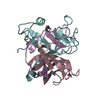

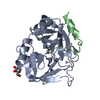

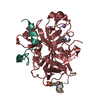
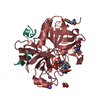
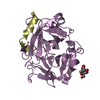

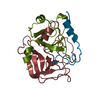
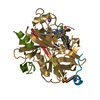
 PDBj
PDBj













